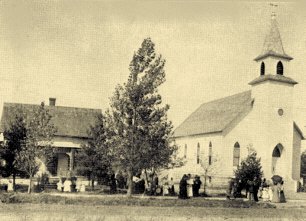
Church: Withee, St. John's History (1890-1964)
Transcriber: Stan
Withee, WI St. John's Lutheran Church History (1890-1964)
Surnames: BAEHR BITOF BRANDT BRAUN BRUCHERT BUBECK CANDAHL CIZEK ENGEL FIEHLER FREDERICK FREDRICH GROH HEIDEMAN HERZBERG HOFFMAN JAECKEL JONSON KLABON KURING LAABS LANKHEIM LENTZ MISSLING MOLZAN NEIMAG PETKE PREDOEHL ROHLAND RUSCH SCHEDLER SCHREIBER SCHREIN SCHROEDER SCHULTZ SCHWARTZ SCHWENKE SCHWERTFEGER SELL SIEVERT SPAETH STAEGER STAPEL TIMMERMAN URMAN WENDLING WUEBBEN ZIELSKE
----Source: Published by Withee, WI St.
John's Lutheran Church for the 50th Anniversary Observance of the
Church Building--authors unknown.

Withee, WI St. John's Lutheran Church History (1890-1964)
Our beginning in Christ
....
On February 22, 1903 seven men gathered after Sunday Services in
the home of William Brandt, believed to be located at the present
site of Altenburg Auto Co. Their Purpose -- to create an official
congregation to carry on the work of their Lord. There present on
that Washington's birthday more than sixty years ago were William
Brandt, August Brandt Sr. August Brandt Jr., August Bruchert,
Edward Neimag, John Schwartz, Frank Heideman and the Rev. Adolph
Kuring, pastor of the Zion Lutheran Church of Colby.
The constitution adopted that day begins "Since according to God's
Word (I Cor.14, 40 Col. 2,5) everything in a Christian Congregation
should be done in order, we a number of German Lutherans, have
united to form one parish." It further states that "The
congregation accepts all of the canonical books of the Old and New
Testament as God's revealed word and adheres to all the
confessional writings of the Lutheran Church, taken from the Bible
and as contained in the Book of Concord (1580) as the rule of faith
and conduct. There are: The Apostle's Creed, the Nicene Creed, the
Athanasian Creed, the Unchanged Augsburg Confession with its
Apology, the Smalkald Articles, Luther's Large and Small
Catechisms, and the Formula of Concord."
William Brandt and Edward Naimag were elected elders that day,
August Brandt, Jr. was elected treasurer, and Pastor Kuring
secretary. Other business transacted was the calling of Pastor
Kuring for a salary of 50.00 a year and the decision that the
pastor would hold services in Withee once every four weeks during
the winter and once every two weeks in the summer. It was at this
meeting that the congregation adopted the name "St. John s". It was
also mentioned that 1.00 was to be taken out of the collection each
service pay for the use of the church building, that which
presently is the Methodist Church.
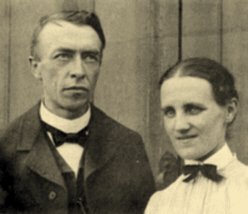
Rev. and Mrs. Adolph Kuring
First Service in 1890
This historic occasion however, does not mark the beginning of
worship by the early German settlers of the Village of Withee for
they had been served by two previous pastors beginning 13 years
before with the Rev. Joseph Fiehler who preached here from
1890-1895, and the Rev. K.G. Bubeck who served from 1896 to 1897.
Rev. Kuring served from 1898 until 1904. All three of the pastors
came from the Zion Congregation at Colby.
When Rev. Fiehler began serving the preaching station in Withee in
1890 the Village was around 20 years old. The first store had
opened just nine years before. The Hamilton Brothers Hotel had been
in operation for less than ten years and the railroad depot was
just eight years old.
Withee's first school was held in the small building of one room,
built in 1883 at the location of the present Woodrow Wall
residence. It is believed that it is here where the first services
of the young congregation were held.
The first wedding recorded was held in 1899 in the old Frenchtown
School, when vows were spoken by Jacob Staeger and Anna Bruchert.
The first baptism on record was that of Erna Auguste Wilhelmine,
child of Carl and Emilie Schulz in 1893: the first funeral was that
of Anna Elizabeth Jaeckel in that same year.
As the turn of the century neared and the official forming of St.
John's congregation was not too far off, the Village of Withee
progressed into quite a thriving community. 1900 found in the
village, three hotels, a drug store, two barber shops, a shoe
store, five general stores, a baker, two creameries, a cant hook
stock and broom handle factory and two mills. Early in 1901 steps
were taken for the incorporation of the Village and incorporation
came that same year.
Written church records are unavailable for the period between 1904,
when Rev. Kuring left, and 1907. It is known that in those years
the congregation was served by Rev.E. Buenger from the Green Grove
church and Rev. Oswald Lugenheim from the Colby Congregation.
Pastor Schrein Begins Ministry
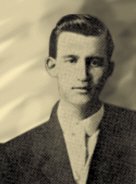
Rev. B. H. Schrein
In 1907 Rev. B.H.Schrein, a young student minister who served
several congregations, began to serve the Withee Church. It was
sometime during his ministry here, 1907 to 1912, that the parsonage
was purchased and St. John's had its first resident pastor.
Previously Pastor Schrein, like the pastors before him, had
traveled to Withee by train and would be housed by members of the
congregation until the next day when he could take a train home
again. It is recalled that Pastor Schrein most often traveled by
bicycle, covering the miles between his congregations at Withee,
Stanley, Reseburg, Chippewa and Thorp in this way.
Harold Heideman has vivid memories of the pastor pulling his tooth
with a string on one of his visits with the Heideman family.
First Confirmation Class
Pastor Schrein conducted the first confirmation class in Withee in
1908. Prior to this most children were confirmed at the Colby
church. Mrs. Ehma Bruchert recalls that she lived most of one
winter at the parsonage in Colby so she could attend confirmation
classes. Members of that first Withee class were Harry Baehr, and
Mabel, Elsie and John Schwartz. Since the pastor was not yet living
in the Withee parsonage, John Schwartz, Sr. would pick him up from
the train and drive him to his home where the classes were held.
The Schwartz home was located across the road from the Baehrs.
Pastor Schrein would stay over night with the Schwartz's and then
Mr. Schwartz would take him to the train the next day.
Both Harry Baehr and his wife (who was confirmed by the same pastor
but in the Reseburg congregation) have fond and clear memories of
the young pastor. They remember him as a "tall slim fellow" who
used to play games with the children, such as fox and geese in the
winter time. They recall that he was not a strict teacher in the
catechism class but rather that they had "pretty much fun".
During Pastor Schrein's term of service in Withee, the congregation
continued to viorship in the Methodist church building.
Rev. Schwertfeger recalls Building problems

Rev. F. Schwertfeger
Rev. F. Schwertfeger was the
second resident pastor and served St. John's at the time the church
was built. Rev. Schwertfeger, now living in Horicon, Wisconsin
remembers very clearly the problems facing the church at that time.
He writes:
"Allow me to extend my heartiest congratulations for the occasion
of the fiftieth anniversary of your church building of St. John's
of Withee. Even today, after fifty years, I must marvel at God's
grace and blessing, when I think of the almost insurmountable
difficulties of that day confronting us in the erection of a church
building. These difficulties were not caused by a lack of devotion
or consecration on the part of the members, but rather lay in the
extreme poverty of most of our members at that time. Yes, many of
them were desperately poor. They had come from Chicago and
purchased small tracts of cut over land, on a land-contract basis
and were just beginning to clear small portions for farming. Quite
a few lived in log-cabins and their only possessions seemed to
consist of a few chickens, a cow, and perhaps a horse or a yoke of
oxen. During the winter months they worked in the lumber mill at
Owen for 1.35 a day (ten hours) and in the spring and summer they
cleared the land and planted small patches of grain. Of course,
there were also a few fairly well established farmers, but they too
were far from being wealthy. All wanted a church of their own, but
despaired of being able to build one.
"I had come to the Withee parish, consisting of Congregations at
Withee, Thorp, Reseburg (a rural congregation three miles south of
Thorp and now amalgamated with the Thorp Congregation) and Stanley.
Later on I also began preaching in the Finnish Lutheran Church at
Owen (english). The congregation at Withee had purchased a
parsonage and two adjoining lots just north of the parsonage, on
their own, shortly before I arrived, but worshipped in an
Evangelical Church just south of the R.R. Tracks on the road to
Greenwood. In this church I was inducted into my office. However,
soon after we were informed that this church would not be available
to us after a certain date in the near future.
No other building suitable for worship was to be found in the whole
town.
"To survive, we were compelled to build. But when I suggested that
to the congregation I was told that it would be impossible. One
excuse was that a debt of $300.00 still rested upon the parsonage.
To encourage the people, I promised to visit the other
Congregations and ask them to help us liquidate that debt. They
were still very skeptical, but I gained the impression that
redeeming the mortgage would stimulate a church-building program.
So I borrowed a horse and a two-wheeled cart from a Mr. John
Schwartz, a member of the Withee Congregation and canvassed the
other congregations for contributions and by the grace of God
actually succeeded in collecting the $300.00. And that did
encourage the people. They were a little more hopeful.
"I do not recall whether they elected a building-committee, in all
probability they did, but the work of collecting and securing
pledges was again up to the Pastor and to him alone. However, that
should not reflect upon the people. In rural congregations in those
days that was the common procedure. So this time I borrowed a
bicycle from one of the boys and sought to raise money for the
church, and after much effort succeeded to raise about $900.00.
This was not sufficient. We needed at least $1500.00. This I
reported in the next congregational meeting, gave them a little
pep-talk and asked if they could not do a little better. Some
responded and after that meeting we managed to get a little over
$1300.00.
"Now we consulted a contractor, a man by the name of Matson, who
lived just a five doors away from the parsonage, and after many
consultations, he consented to build this church for $3,000.00 if
the congregation would dig the basement. Here again, Mr. Schwartz
deserves a lot of credit. He dug that basement almost
single-handed. But how could the balance be raised I applied to the
District Church Extension Fund and was told, since we were not a
subsidized parish, no loan could be made. One other source
remained. I applied to the Aid Association for Lutherans in
Appleton and to my great joy they loaned us the balance of
$1,500.00 at three per cent.
"An altar and a pulpit were presented to us by a congregation in
Chicago. I believe it was a Jehovah congregation. The altar was
rebuilt for our church by one of our members Also a reed-organ was
given to us by a traveling salesman. This organ was in storage in
Burlington and the condition was that we pay the freight, which
amounted to six dollars. That organ was in very good condition and
served, as I understand, for quite a few years.
"So the church was built and dedicated in September 1914. The other
congregations of my parish were invited and the collection exceeded
my fondest expectations, over $200.00, so that we could pay the
contractor in full. To meet the interest payments and to reduce the
loan, we now introduced envelopes and through this system succeeded
to pay off on our mortgage even after the first year. That briefly
is the history of the Lutheran Church in Withee, as I-remember it.
It was the grace and blessing of God which made it possible. Soli
Deo Gloria."
The church records indicate that a building committee was
appointed, consisting of Pastor Schwertfeger, John Schwartz,
William Missling and Henry Petke, who was authorized to draw up
plans for the building. The plan called for a building 32 x
50'.
In the Annual Meeting of January 1, 1914 the voters decided to
borrow the needed $1,500.00 and reported a cash balance on hand of
$27.64. At the samemeeting a rule was adopted for new members, that
they pay at least $8.00 for pastor's salary. It was also decided
that each member furnish 4 yards of gravel or $5.00.
As 1914 continued, a committee, consisting of Fred Plader, Edward
Neimag and Edward Missling, was chosen to purchase benches. Money
was to be collected from the members.
Owen Congregation Formed
It was in 1916 that Rev. Schwertfeger began preaching at the
Finnish Lutheran Church in Owen. That congregation, formed on
October 7, 1916, was the English Evangelical Lutheran Zion
Congregation. This congregation operated as a mission station being
served by Withee Pastors until 1942 when it was officially combined
with St. John's and its membership was transferred to the Withee
Congregation.
First signers of the constitution were, besides Pastor
Schwertfeger, E. A. Schroeder, E. F. Rusch, Arthur Sdhwenke, Gust
Braun, Louie Herzberg, Mrs. Charles Spaeth, Mrs. Caroline Candahl,
Inga Jonson, August Sell, William Schultz, and one other
member.
Elected to the first term of office were Arthur Schwenke,president
E.Schroeder,Treasurer and E. F. Rusch, secretary.
The Owen congregation had an active Ladies' Aid and a Sunday School
of over 40 pupils.
Through the years of its existence it was called upon to help with
the upkeep of the parsonage at St. John's.
The mission station closed on Jul 19, 1942 in accordance with
action taken at a Jul 12th meeting. The application for the
transfer of the members of the Zion English Lutheran Church was
made possible by a motion by Louis Klabon, seconded by Edward
Frederick.
Pastor Schwertfeger remained until March, 1917.
Rev. H. Laabs served as resident pastor for one year, 1917-1918. It
was during this time, in February, 1918, that St. John's resolved
to enter into membership with the Missouri Synod. That fall Mr.
Edward Missling was sent to the district convention at
Clintonville, Wisconsin. Julius Petke and Mr. Sievert traveled
around in the District to collect some money to help Withee pay off
its debt on the new church.
In Jul of 1918 an extra meeting was held to welcome into
membership Edward Fredrich, John Rohland, William Lentz, John
Engel, Julius Cizek, Fred Molzan, Jak.Cizek, Karl Bitof, Fred
Schwenke, John Lankheim and Ludw. Schafer. This group had come from
Chicago and had purchased a school building in which to hold Polish
services. In view of the fact that the group still had a debt to
retire on the school the voters of St. John's decided to release
them of any obligation of church debt retirement. At the same
meeting it was decided to permit a pastor to come three times a
year for the purpose of holding services in the Polish language for
those members not too well acquainted with the German.
Pastor Otto Schreiber from the Greenwood congregation served for
one year as vacancy pastor. Pastor Schreiber, now living in Suring,
Wisconsin, writes:
"One thing I never forgot was the hearty singing in your church
services. When I'd get there for a service the "short" Petke (there
was also a "long", but I do not remember their first names) would
ask for the hymn numbers in the German and the English hymnbooks.
Then he would also look up the numbers for the same hymns in the
Polish hymnbook and then post all three lists on the hymn board.
And then each one sang in the language he or she preferred. And it
almost seemed as though each one tried to have his language heard
above the others. I had a visitor with me one Sunday. He was from
the southern part of the state. After the service he told me 'My
those people sure can singl They almost raise the roof with their
singing. Such hearty singing we do not hear in our part of
Wisconsin., "Now I wish to assure you that I join you in thanking
God for the Spiritual Blessings he has bestowed upon you in your
church services these past fifty years and also in praying to God
to continue to bless you also in the future. May He in His Grace
preserve unto you the preaching of His word in its truth and purity
and also grant you His Holy Spirit's power to accept and believe it
for the saving of your souls here in time and hereafter in
eternity. So that if we should not meet again here on earth, we
will celebrate a glad reunion before the throne of God in heaven.
Amen."
Withee Congregation Leaves Parish
On Jul 6, 1919 it was voted to separate the Withee Congregation
from the Thorp, Reseburg, Withee parish and call a pastor for St.
John's.
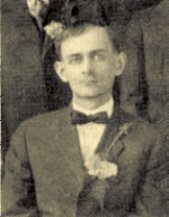
Rev. H. Laabs
Calling continued until sometime late in 1919 when Pastor Laabs
returned to Withee to remain resident pastor for three years until
1922.
On February 29, 1920 at the annual meeting the voters decided to
have an English service the first Sunday in each month.
Pastor Groh Installed
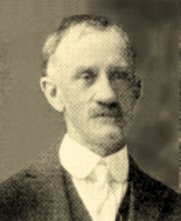
Rev. George Groh
Pastor Groh as installed here on May 28, 1922 and in 1924 the
congregation celebrated the 10th anniversary f the church building.
At this time the congregation was thinking about acquiring a bell
for the church. In a meeting on Jul 26, 1925 it was announced that
electric lighting had been installed in the parsonage.
In December, 1926 Pastor Groh received a call to Milan, Wisconsin
and was given a release. Pastor Stapel of Thorp served as interim
pastor with a salary of $30.00 per month. The parsonage was rented
and the rent money applied n the church debt.
Rev. Stapel served from 1927 to 1928.
In January 1928 a special meeting as called to see how much money
could be raised towards pastor's salary. After much discussion, it
as decided to call another pastor, to raise $600.00 annually toward
his salary, and to ask the mission board for assistance. Pastor
Wuebben of Abbotsford as engaged as vacancy pastor at $30.00 per
month.
Pastor Hoffmann Accepts Call
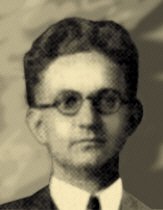
Rev. O. Hoffman
In February 1928 a call was issued to Pastor Otto Hoffmann of
Libby, Montana, who accepted the call and came to serve the Withee
church for 2 years, 1928-1930. Pastor Hoffmann, now living in
Clearwater, Florida, sends his greetings to the congregation."
"We certainly are happy with St. John's Lutheran Church of Withee
that the members can look back on 50 years of service in the
Kingdom of their blessed Lord. While its beginning was modest and
unassuming, yet after these 50 years of service the congregation
can lift its head in humble pride to give glory to God for all the
blessings He had so graciously bestowed upon the members, past and
present, and through them upon others in the name of Christ.
"While we only served the congregation for two years, yet our
memories of the congregation are fond memories of willing service
to the Lord.
"It is our sincere prayer that the Lord will continue to bless the
congregation and its members and that the members will continue to
serve the Lord to the glory of His name and the eternal welfare of
souls purchased by the precious blood of Christ.
"We wish we could be with you on the anniversary, however, distance
will not permit this. One of these years we will journey northward
and then e will surely pass through Withee and visit with such as
remember us."
In November 1928, the voters decided to raise $675.00 for the next
year's salary for the pastor and to ask the mission board for
$525.00 to make up the balance. It was also voted in this meeting
to have the Thanksgiving service in German and also in English, the
Christmas Eve service in English, and the Christmas Day and New
Year's Day services in German. At the same meeting members were
reminded to bring wood to heat the church.
In October of 1929 the voters lowered their request to the mission
board by $25.00, and asked for $500.00 assistance. At this meeting
it was decided to toll the bell during the Lord's Prayer and do
away with the custom of separating the men and women during the
service.
A financial report in January, 1930 showed total receipts of
1,115.31 and a disbursement figure of $1,063.31.
On February 23, 1930 a release was given to Pastor Hoffmann who had
received a call from the Colby congregation. On March 30, 1930, the
voters decided to call a 1930 graduate pastor, and if possible, one
acquainted with the Polish language. It was also decided to engage
a student to serve the congregation in Jun and July.
Pastor Wendling Here During
Depression
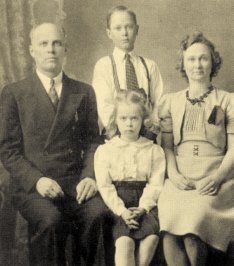
Pastor Wendling and Family
On October 5, 1930, Pastor E. L. Wendling was ordained and
installed and began a term of service of 11 years. Pastor Wendling,
who now lives in Waupaca, Wisconsin, writes:
"We enjoyed our stay at Withee, though the going was rather hard.
These were depression years when farmers were losing their farms,
getting only about 75 cents per hundred pounds of milk. The Pastor
was to receive $85.00 per month, but didn't always get it. The
money just wasn't there. Still the Lord provided for us. The people
were good to us. When they had no money, they gave us food and the
like."
That the "going was rather hard" is plain also from the minutes of
the congregation. On October 9, 1932 the voters could not decide on
a specific amount of money to raise but agreed to raise as much as
possible. On January 8, .1933 it was decided to reduce the pastor's
salary from 700.00 to 550.00 for 1932 and 1933 and in a 1935
meeting the 52.00 delinquent salary money due the pastor was
canceled upon the okay of the pastor.
In April of 1935 the young people of the choir purchased another
organ for the church and the old organ was given over to them.
The next year the church and parsonage were painted and a new
cement floor was put in the church basement. An interesting note in
the January 3, 1937 Minutes states: "It was decided to begin
services promptly on time henceforth, and from Jun to Christmas at
10:30 A.M. From Christmas to Jun 1st at 10:45 A.M."
In May 1938 it was decided that English services be conducted every
Sunday morning at 10:00 and German services be held every 1st and
3rd Sunday immediately after the English service.
For 1939 the congregation pledged 650.00 for salary. That same year
a new culvert was placed in front of the garage.
In the fall of 1939 the 25th anniversary of the church building was
celebrated. Pastor Schrein of Chippewa Falls and Pastor Hoffmann of
Colby were invited to speak. In the same year it was announced that
the Ladies' Aid had offered to pay expenses for a partition through
the basement, for wallboard on the ceiling, and paint on the walls.
The offer was accepted with thanks.
In the Quarterly meeting of October 29, 1939 it was decided to
change the service to the extent of having all prayers said at the
alter rather than at the pulpit.
Witness Placed in Every Home
In the January 7, 1940 meeting it was resolved to make an effort to
place the Lutheran Witness or the Lutheraner into every home of the
congregation. The treasurer reported that $166.00 had been raised
for missions during the last year, $26.65 for the centennial
offering and $727.00 for home expenses.
In the same year it was decided to put a new roof on the parsonage.
Ed Fredrick and Adolph Cizek were appointed as delegates to a
Laymen's meeting and Ed Petke was appointed delegate to Synod.
In a later 1940 meeting it was decided to have the young men of the
congregation act as ushers. For the year 1941 the congregation
increased its pledge for the pastor's salary to $675.00 and
consequently the subsidy requested from synod was $25.00 less.
World War 11 The minutes show the effect of World War 11 on the
Withee church when it reports that it was decided to purchase New
Testaments for the boys at the camp and later that in case a member
of our congregation should fall in service to his country that a
prayer be read for him at the time of death and a memorial service
be held for all fallen members once a year.
On November 16, 1941 Pastor Wendling was given a peaceful release
in a special meeting, held jointly with the members of Zion
congregation of Owen. It was decided to ask Pastor Hoffmann of
Colby to serve as vacancy pastor.
Rev. Schedler Arrives
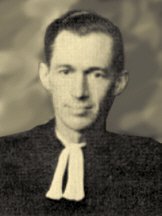
Rev. Schedler
In a December 7, 1941 meeting Pastor Walter Schedler was elected to
receive the call from the Withee church. Pastor Schedler accepted
the call and arrived in January. Pastor Schedler, now serving in
California writes:
"My ministry at Withee began in January of 1942. When we arrived we
were directed to Mrs. Bruchert's home where we were treated to a
lovely meal. After supper my wife and I went to the parsonage and
got a few beds set up so we could spend the night there. It was
cold and it was a cold house.
"The installation service was in the afternoon and Rev. O. Hoffmann
of Colby installed me.
"I had my first baptism a few days later. I baptized Judith Auberg,
the daughter of Mr. and Mrs. Roy Auberg. I had her in my
confirmation class in 1954, the year I left to go to Bear
Creek.
"The work at Withee was quite hard at first and progress was slow.
But soon some of the younger men took a hold of things and progress
became more rapid. At this time Withee was under the mission board.
Withee paid $60.00 per month and the district $40.00. I believe we
went self supporting in 1945 or 1946.
"Some of the physical changes that took place were the insulating
of the house and then the church, the work being done by Albert and
Ernest Petke. If I m not mistaken they charged only $95.00 for the
parsonage.
"The church also got additional lights at this time and the
parsonage got hot running water and a bathroom. Then the church got
an oil furnace and the basement fixed up nice. Also the parsonage
got an oil furnace and an electric water heater. Next the church
got a mother's room and another exit from the basement. We also got
sidewalks around to the back of the church and over to the
parsonage. The amplifying system was installed by John Isaacs for
$100.00 with the congregation, Ladies' Aid, and Men's Club sharing
the expenses. Also the movie projector was added pretty much in the
same way. And let's not forget the rebuilt reed organ we bought
that gave us so much trouble, especially the blower and how it was
then replaced with the present Hammond which was paid for before 90
days of free loan were up.
"Spiritual growth came in a very gratifying way. God's Word was by
no means preached in vain. The mission contribution went from
hundreds of dollars to over $1500 per year and the church
attendance from an average of 50 to 145. All this because the Lord
was working in the hearts of the people of Withee and vicinity and
because the people worked together. People spoke well of St. John's
Lutheran Church and many also spoke well of the pastor. These two
things do help so much to draw attention to the local congregation
where the outsider will then also come and hear the soul-saving
word. I do believe that these two things were a contributing factor
to the fact that so many adults were confirmed during my ministry
there. Of course, it brought great joy to me to confirm these
adults after a 3 to 4 month period of instructions. Truly the
Gospel is the power (dynamite) of God unto salvation to everyone
that believeth.
"I wish I could be with you on such a happy occasion. May the Lord
continue to bless all of you and May all of, you continue to serve
the Lord faithfully."
Additional highlights of Pastor Schedler's ministry here were the
adoption of the pastor's pension plan in April, 1942, the combining
of Zion Lutheran Church of Owen with St. John's of Withee in July
of 1942, Vacation Bible School began in the summer of 1948 Sunday
German services were discontinued in 1949 the 50th anniversary of
the congregation was observed in May of 1953, with Rev. Schrein,
Rev. Schwertfeger and Rev. Clarence Cizek invited to speak, and the
40th anniversary of the church building was observed in 1954.
Rev. Schedler was given a peaceful release to accept a call to Bear
Creek, Wis., at a special meeting on November 14, 1954. At the same
meeting the voters decided to ask Rev. Brauer of Greenwood to serve
as vacancy pastor.
Rev. Predoehl Sends Greetings
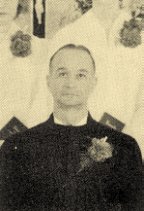
Rev. Predoehl
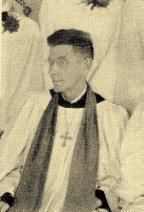
Rev. Brauer
Pastor Brauer served the congregation for 6 months. Pastor Theodore
Predoehl was installed on Jun 19, 1955 and served until April of
1961. Pastor Predoehl writes from Glidden, Wisconsin:
"May the Holy Spirit guide all to gladly hear God's Word, be
touched with the heavenly fire ,and be saved by the grace of God in
Christ.
My family and I extend our best anniversary wishes to St. John's
congregation as they observe the 50th Rev. Brauer anniversary of
their church dedication in Sept. 1964.
During Pastor Predoehl's term of service it was seriously
considered by the congregation to build an addition to the present
church structure but for various reasons this project was never
brought to completion.
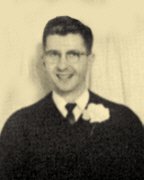
Rev. Harold Timmerman
After Rev. Predoehl left, St. John's experienced a vacancy of a
little more than one year during which time the congregation was
served first by Rev. Harold Timmerman of Green Grove and then Rev.
Daniel Zielske of Greenwood. The vacancy was highlighted by many
call meetings, a Spiritual Life Mission project, and finally the
building of a new parsonage on the lots across the street from the
church.
Rev. Urman Installed in 1962
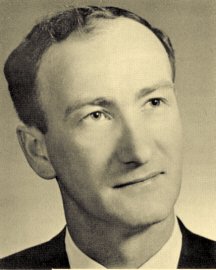
Rev. Leroy A. Urman
In January of 1962 the voters decided to issue a call for a
graduate student and on Jul 8, 1962 Pastor Leroy A. Urman, a
graduate of Concordia Theological Seminary of Springfield, Ill.,
was ordained and installed. In January of 1962 the voters decided
to issue a call for a graduate student and on Jul 8, 1962 Pastor
Leroy A. Urman, a graduate of Concordia Theological Seminary of
Springfield, Ill., was ordained and installed.
|
© Every submission is protected by the Digital Millennium Copyright Act of 1998.
Show your appreciation of this freely provided information by not copying it to any other site without our permission.
Become a Clark County History Buff
|
|
A site created and
maintained by the Clark County History Buffs
Webmasters: Leon Konieczny, Tanya Paschke, Janet & Stan Schwarze, James W. Sternitzky,
|